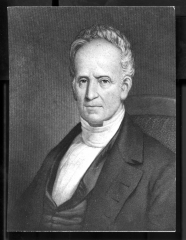In addition to Kendrick, Clark, Olmstead, and Daniel Hascall, the personnel of the Committee included Elon Galusha, John Peck, and Seneca B. Burchard. Galusha, son of Jonas Galusha, a former governor of Vermont, was making a reputation at Whitesboro as one of the most eloquent Baptist preachers in the State. He was later to figure prominently in the antislavery controversy which would split the denomination in the ‘forties. “Father Peck,” the greatly loved and benign pastor of the Cazenovia church, subsequently became well known as a far-ranging agent for home and foreign missions. Burchard, one of the most important of the stalwart laymen intimately associated with the Institution, left a record of service matching that of Olmstead. A newly appointed faculty member in a confidential letter described Burchard and Olmstead as “two very grave and sober and considerate and economical Deacons. They are shrewd and judicious men, however, and are perhaps the fairest representation of the whole Bap. Community with whom we have to do.”*
The high point in the year was the Society’s Annual Meeting,usually held, the first week in June. The date was fitted into the schedule of “public examinations” of the students and the “public exercises” of the juniors and seniors. At this time the officers of the Society brought together all those interested in the Institution. The procedure on these occasions resembled that of the meetings of Baptist associations with which Kendrick and his associates were familiar. A sermon by a well-known preacher selected long in advance opened the program and no doubt attracted a crowd of rapt listeners who, it was hoped, would stay through the remainder and really more important part of the meeting. From the various reports then submitted they learned of the year’s achievements and the problems and hopes for the future. The last item of business was the election of Trustees, who in turn immediately chose their officers.
With the exception of the first two, all meetings convened in Hamilton, probably at the Baptist meeting house until the Society had halls of sufficient size in its own buildings. The Reports of the occasions, which were prepared almost entirely by Kendrick, constitute one of the most enlightening sources for the history of the Institution. Announcements and news about the Seminary also appeared in the New York Baptist Register, the State organ of the denomination published at Utica. In the first issue, February 20, 1824, Elon Galusha
* Joel S. Bacon to George W. Eaton, Georgetown, Ky., Aug. 28, 1833.





